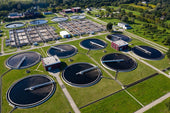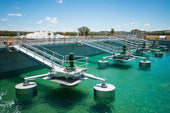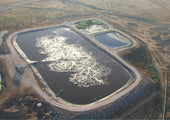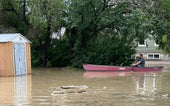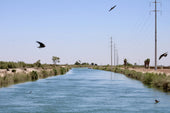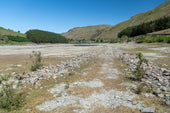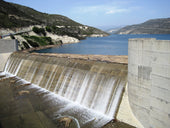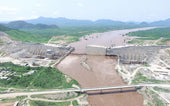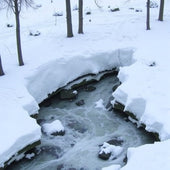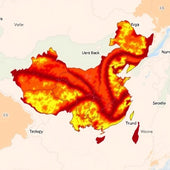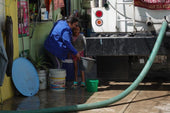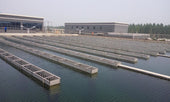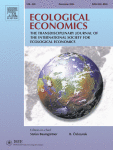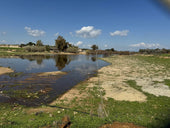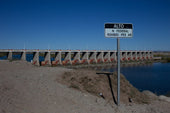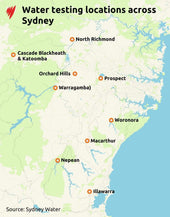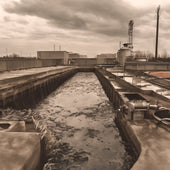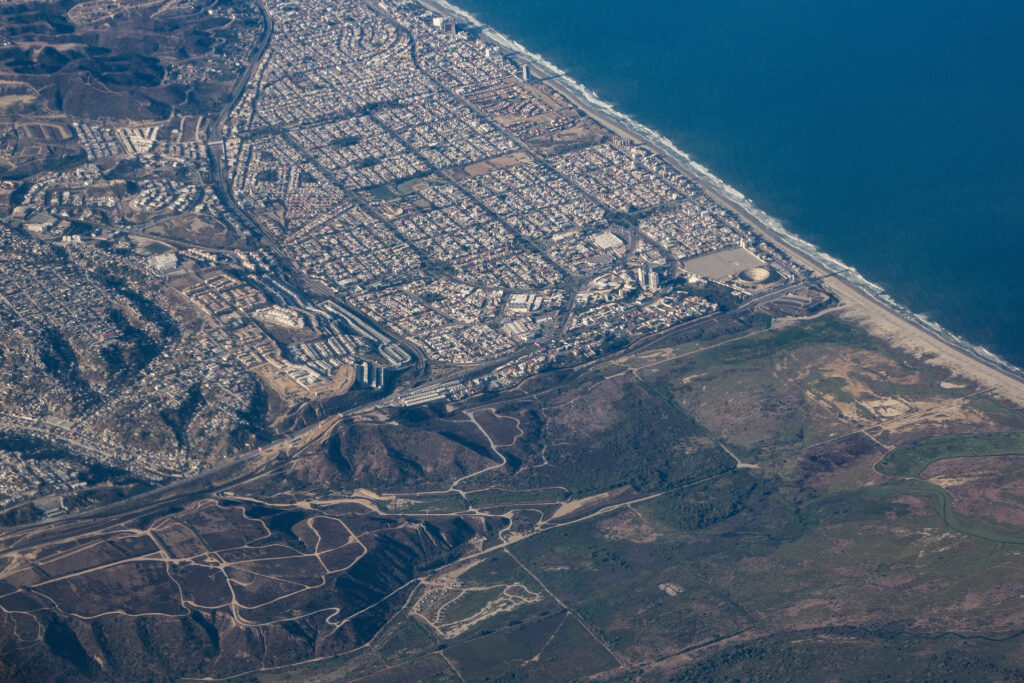
EPA Head Pushes Mexico to Address Tijuana River Sewage in Recent San Diego Visit
Water knows no borders. Unfortunately, neither does sewage.
Each day, the Tijuana River carries millions—and sometimes billions—of gallons of sewage across the U.S.-Mexico border into California, where it dumps into the ocean. This wave of waste frequently overwhelms wastewater treatment plants in both countries, fueling a public health and environmental crisis in nearby San Diego communities. The problem has gotten worse in recent years as budget-strapped infrastructure deteriorates and climate change fuels increasingly intense storms.
Last week, the Environmental Protection Agency’s administrator, Lee Zeldin, visited San Diego County to urge a “100 percent solution” from Mexico and the U.S. for ending the flow of untreated wastewater. He told reporters that a meeting with Mexico officials went well but stressed that the U.S. is “all out of patience.”
“There’s no way that we are going to stand before the people of California and ask them to have more patience and just bear with all of us as we go through the next 10 or 20 or 30 years of being stuck in 12 feet of raw sewage and not getting anywhere,” Zeldin said at a press conference.
Local leaders and residents are tentatively optimistic about the visit, but their hopes are tempered by years of unfulfilled promises from former officials.
A History of Sludge: The Tijuana River spans around 120 miles through northwest Baja California and the Tijuana River Valley in southern California, supporting an abundance of wildlife, plants and people.
Tijuana, Mexico, has struggled to keep pace with its population boom in recent decades. Part of the problem is that more people means more waste. During its winding journey to the Pacific Ocean, the Tijuana River is polluted by sewage, trash and industrial chemicals from urban areas, where people often dump refuse directly into the water or onto the streets, where it washes in. There are two main treatment plants to remove solids, pathogens and contaminants from the sludge—the San Antonio de los Buenos Treatment Plant in Mexico and the South Bay International Wastewater Treatment Plant in San Diego.
But both plants have grown increasingly dilapidated over the years of constant use, and much of the wastewater passes by into California untreated.
As a result, doctors and researchers have documented a surge in gastrointestinal illnesses in San Diego communities around the border, particularly in Imperial Beach, San Ysidro and Coronado. A growing body of research has identified unsafe levels of hydrogen sulfide in the air surrounding sewage hotspots in the river.
A recent report from the Department of Defense’s Office of Inspector General found that around 1,100 cases of illness were documented among Navy SEALs and other service members who were exposed to the sewage-laden waters in recent years. Some beaches in the area have been closed for over 1,000 days to prevent more public health risks. One study found that bacteria from sewage pollution has even infiltrated ocean spray in the air after a wave crashes.
The problem is particularly bad during storms such as the atmospheric rivers that slammed San Diego in 2024, which I covered last February. I spoke to public officials and residents about the issue, including Jose Cariman, a San Ysidro resident. He confirmed what you have probably all been thinking when you heard the word “sewage”: Yes, it smells.
“It’s horrible,” he told me last year. “The quality of life is diminished a lot, the price of the house is diminished ’cause who wants to buy a house in the neighborhood that smells like sewage?”
Due to the ongoing pollution and lack of investment in sewage infrastructure in the region, the nonprofit advocacy group American Rivers deemed the Tijuana as the second most endangered river in the U.S. in a recent report.
And climate change is set to make the problem worse, according to Ann Willis, the California regional director at American Rivers.
“When we dump sewage into the river, we’ve taken something that is fundamentally a part of the circulatory system of the Earth, and we’ve turned it into a toilet pipe,” she told me. “We have a [wastewater treatment] system that’s already undersized for the amount of pollution that’s being produced right now. So then, when we imagine that somehow it’s going to have to carry more rainfall that’s falling more intensely, more frequently, this is what really challenges our infrastructure.”

EPA Visit: Early last week, Zeldin traveled to San Diego to survey the Tijuana River sewage issue, which he said is “top of mind” for President Donald Trump. He toured the southern border via helicopter, visited with Navy SEALs at the Naval Special Warfare Center and conferred with Mexican officials, including the country’s secretary of environment and natural resources, Alicia Bárcena.
Zeldin also met with local officials, among them the mayor of Imperial Beach, Paloma Aguirre, who invited him to visit before he was even confirmed as head of the EPA. I checked in with Aguirre—who has been one of the most outspoken officials for years in the push to stop the sewage—to see how it went.
“We are all feeling cautiously optimistic because my overall impression from the administrator is that [Zeldin] gets it and he’s willing to take action to address the most pressing issues related to the river,” she told me. “I was able to communicate to him clearly my core concerns, which are, first and foremost, the health impacts to the people of Imperial Beach and beyond.”
Congress has appropriated $653 million to repair and expand the South Bay plant to increase the capacity from 25 million gallons of wastewater per day to 50 million gallons. In 2022, Mexico pledged $144 million to help address the issue, but has not yet fully followed through. The Mexican government says that it is nearly finished with repairs on the San Antonio de los Buenos Treatment Plant, which could help reduce some of the flow of untreated wastewater into the U.S.
But Tijuana generates an estimated 100 million gallons of sewage per day, Axios reports. That means these upgrades still won’t be enough, Aguirre said. During his visit, Zeldin suggested expanding an ocean structure that carries wastewater from the South Bay plant and discharges it further from the coast to reduce risks to people, the San Diego Union-Tribune reports. The EPA administrator stressed that collaboration could help hasten upgrades, but that Mexico must step up in the effort.
“Mexico needs to fulfill its part in cleaning up the contamination that they caused,” he said during a news conference last Tuesday. “They cannot view this as a U.S. problem just because their contamination reached U.S. soil.”
I checked in with Cariman to hear his thoughts on Zeldin’s visit.
“The visit from Mr. Lee Zeldin was good, but still does not address the real issue. We can put a bandage on the situation but it doesn’t fix the problem. Tijuana will continue to dump the sewage into the Tijuana River,” he told me over email. “This is only going to stop when Tijuana decides to build more sewage treatment plants, fix the current failing sewage plants and connect all the buildings to a new sewage system.”
Aguirre and other politicians, such as U.S. Sen. Alex Padilla (D-Calif.) have called for an emergency declaration to ramp up funding immediately for treatment plant upgrades and other infrastructure to divert pollution from coastal communities.
For now, Zeldin said U.S. and Mexican officials soon plan to release a “specific statement from both countries” outlining actions the Mexican government will take to help tackle the sewage issues, the Los Angeles Times reports. I reached out to the EPA to ask about the timeline on this project and what concrete actions would be taken, but the agency did not answer those questions. I also reached out to the International Boundary and Water Commission, which owns and administers the South Bay plant.
“[We] are working closely with the Administration to get this project finished as quickly and efficiently as possible,” Frank Fisher, the chief of public affairs for the U.S. Section of the International Boundary and Water Commission, said over email.
While Aguirre agrees that Mexico must take more action, she said that “the reality is, we need to do whatever it takes—we cannot afford to wait for Mexico for solutions.”
“It’s very clear that the solutions, first and foremost, need to be implemented in Mexico, because that’s the source of pollution to all of us,” she said. “But at the end of the day, we have an expectation from our state and federal government. As government, we are responsible for the health, safety and welfare of our constituents.”
More Top Climate News
The Trump administration dismissed hundreds of researchers who had been working on a key government climate report, Brad Plumer and Rebecca Dzombak report for The New York Times. The report, required by Congress and published every few years since 2000, usually offers a look at how climate change is affecting each facet of U.S. society—from fisheries to human health.
The information in the National Climate Assessment typically helps business leaders and states prepare for extreme weather and warming impacts, but experts say the future of this climate pulse check is unclear. Dismissing the researchers doesn’t save money even in the short term: All of the scientists and experts working on the report were contributing on a volunteer basis. The Trump administration did not respond to the Times’ request for comment.
Meanwhile, Hawaii lawmakers passed a resolution last week encouraging insurance companies to hold the fossil fuel industry accountable for rising insurance costs by taking them to court, Giulia Carbonaro reports for Newsweek. The resolution states that fossil fuel companies “knowingly engaged in misleading and deceptive practices regarding the connection between their products and climate change.” Hawaii has been hard hit by extreme weather in recent years, such as the fires that tore through Maui in 2023, and some residents have reported major hikes in home insurance premiums as a result—a trend that is happening across the country.
Some good news: In California, wildlife is returning to areas that were burned during the catastrophic Eaton Fire in January, giving hope to local residents, Jaime Ding reports for The Associated Press. Trail cameras installed by volunteers in the region have documented coyotes, deer, a mountain lion, birds and more as greenery starts to grow back in the charred remains of the landscape.
“My first inclination was to share that to people who have lost so much during this fire and our community in Altadena, because it’s a sign of hope that nature’s returning, that nature’s resilient,” Kristen Ochoa, a local resident who is leading the effort, told the AP.
Reporter
Kiley Price is a reporter at Inside Climate News, with a particular interest in wildlife, ocean health, food systems and climate change. She writes ICN’s “Today’s Climate” newsletter, which covers the most pressing environmental news each week.
She earned her master’s degree in science journalism at New York University, and her bachelor’s degree in biology at Wake Forest University. Her work has appeared in National Geographic, Time, Scientific American and more. She is a former Pulitzer Reporting Fellow, during which she spent a month in Thailand covering the intersection between Buddhism and the country’s environmental movement.










